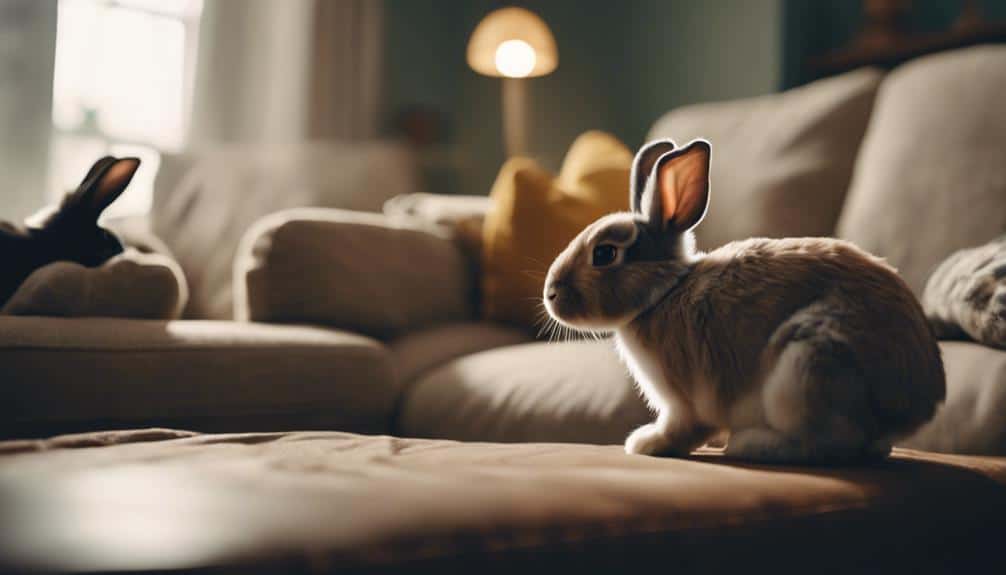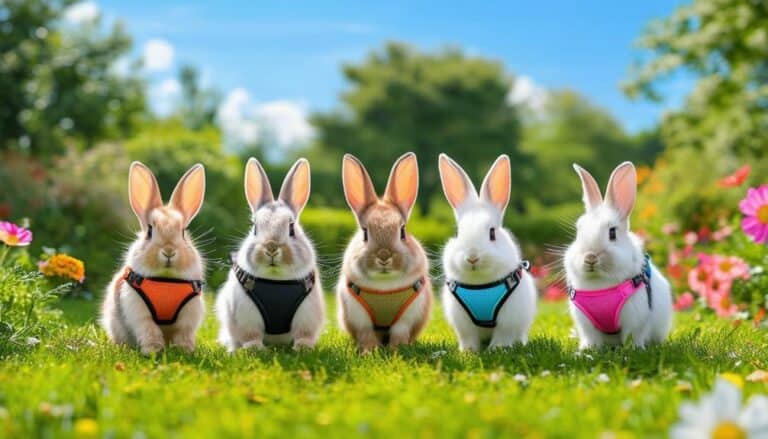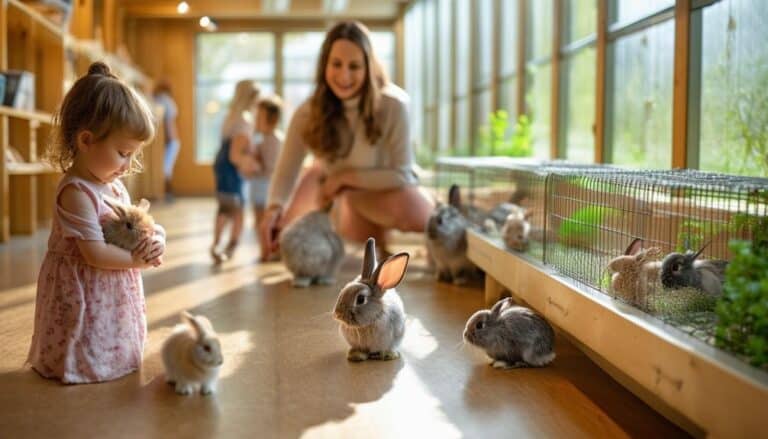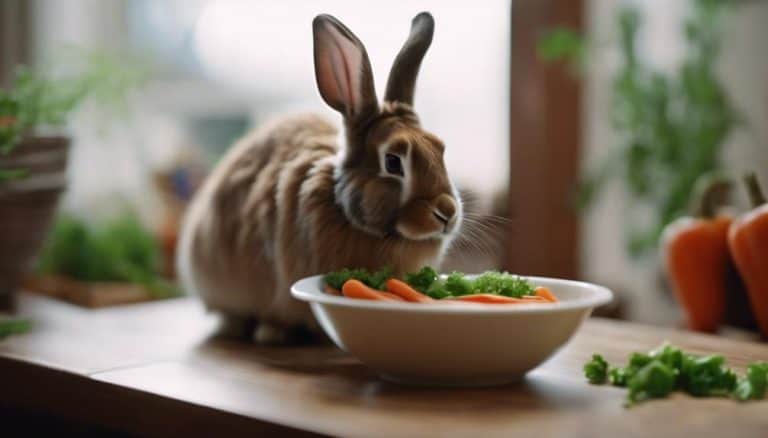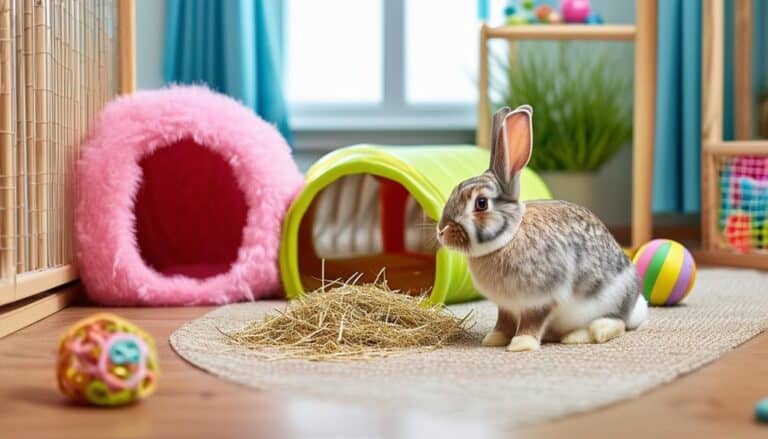Decoding Pet Rabbit Body Language – A How-To Guide
Understanding your pet rabbit’s body language is essential for fostering a healthy and happy relationship. You might notice your bunny thumping its feet or binkying around the room, but what do these actions mean?
By learning to interpret these behaviors, you can respond appropriately to your rabbit’s needs and emotions. This guide will help you recognize when your rabbit is feeling alert, joyful, or even distressed.
Whether it’s through their playful jumps or subtle grooming habits, your rabbit is constantly communicating with you. Ready to decode the signals your furry friend is sending? Let’s get started.
Alert and Cautious
When a rabbit is alert, its ears are forward and its whole body is attuned to its surroundings. You’re likely to observe your rabbit’s ears held upright, scanning for any potential threats. Their back legs are ready to propel them into a quick escape if needed, and their front paws may exhibit slight, quick movements indicative of readiness.
Periscoping is a common behavior where your rabbit stands on its back legs, using its heightened position to explore or assess its environment. This stance allows them to check for treats or potential dangers, demonstrating a cautious approach due to their sensitive stomachs.
In situations where your rabbit feels threatened or encounters new animals, you might notice them standing and boxing. This behavior involves rising on their back legs and using their front paws to swat or fend off perceived threats. It’s a clear sign of high alertness and can indicate aggression or territorial disputes.
Understanding these behaviors ensures you can create a safe and comfortable environment for your rabbit, respecting their natural instincts and need for freedom. By recognizing these subtle cues, you’ll better manage their stress and provide a secure habitat.
Joyful Behaviors
Observing a rabbit binky provides clear evidence of their extreme joy and contentment. Binkying, characterized by high jumps with mid-air twists, ear flicking, and head flipping, serves as a potent form of communication, signaling a rabbit’s happiness and pleasure. Not every rabbit exhibits this behavior, as binkying is dependent on individual personality traits and levels of expressiveness. Nonetheless, when a rabbit does binky, it’s an unmistakable sign that they’re thriving in their environment.
Consider the following table to understand joyful behaviors in rabbits:
| Behavior | Description |
|---|---|
| Binkying | High jumps with twists, ear flicking, head flipping; clear sign of joy and contentment. |
| Zooming | Rapid, high-speed running, often accompanying binkying, indicating energetic happiness. |
| Flopping | Sudden collapse onto their side; shows deep relaxation and pleasure. |
| Purring | Gentle teeth grinding; conveys a state of pleasure and contentment, often during petting. |
| Nose Bonking | Gentle bumps with their nose; a social gesture displaying affection and seeking interaction. |
Understanding these behaviors can help you cultivate a more enriching environment for your rabbit, enhancing their overall well-being. Recognizing and fostering joyful behaviors contributes to a fulfilling life for your pet, allowing them the freedom to express their innate happiness and contentment.
Territorial Actions
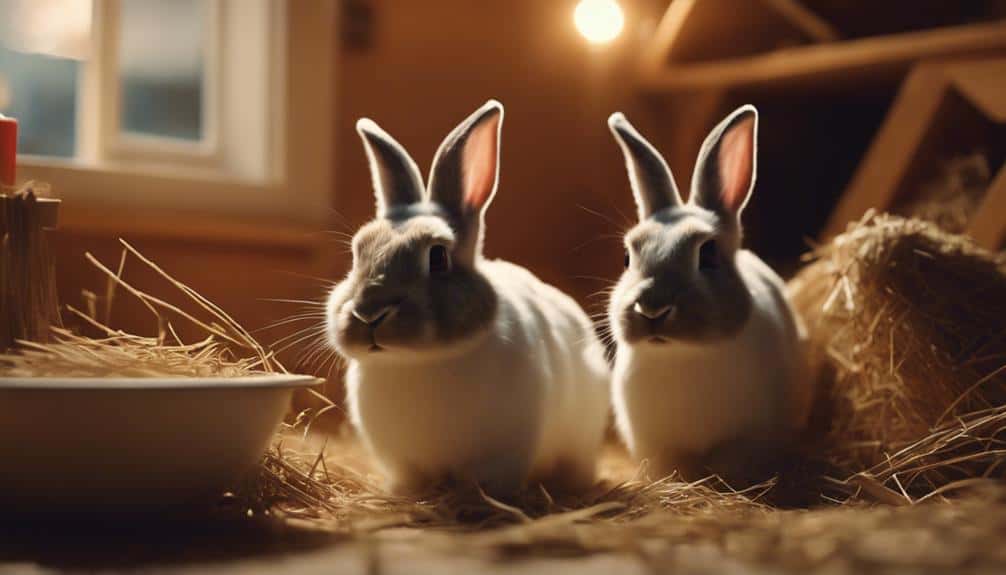
You’ll notice your rabbit exhibiting territorial actions such as chinning objects and dropping fecal pellets to mark their space. Additionally, behaviors like thumping, stomping, and circling are indicative of a rabbit asserting dominance or feeling threatened.
These actions are more pronounced in unneutered males, highlighting the importance of neutering to mitigate aggressive territorial behavior.
Chinning and Marking
Rabbits exhibit a behavior known as chinning, where they rub their chin on various objects to mark their territory with scent glands located under their jaw. This behavior is a fundamental way for rabbits to establish ownership and communicate with other rabbits. When your rabbit engages in chinning, they’re deploying a scent mark that indicates their territory. This instinctual action guarantees that their environment feels familiar and safe, which is vital for their well-being.
By understanding chinning, you can better recognize and respect your rabbit’s territorial boundaries. Chinning can occur on objects, people, or other animals, signifying the rabbit’s claim. This behavior is not only a form of communication but also a way to create a secure environment.
| Behavior | Purpose | Significance |
|---|---|---|
| Chinning | Mark territory | Establishes ownership |
| Scent Glands | Release scent | Communicates presence |
| Rub Objects | Indicate claim | Creates familiar environment |
| On People | Mark ownership | Strengthens bond |
| On Animals | Assert dominance | Maintains social hierarchy |
In a clinical perspective, recognizing these behaviors allows for a more harmonious coexistence. So, when your rabbit rubs their chin on something, they’re not just being cute—they’re broadcasting important information about their world.
Thumping and Stomping
Thumping and stomping are crucial behaviors that rabbits use to communicate fear, alert others to danger, and establish territorial boundaries. When a rabbit thumps its hind legs against the ground, it’s executing a natural, instinctive action to signal potential threats or disturbances. This powerful form of communication is essential for their survival in the wild and remains impactful in domestic settings.
Stomping can also manifest as a defensive behavior. When a rabbit feels threatened or agitated, it may stomp to assert its need for space, effectively warning intruders to stay away. The intensity, frequency, and duration of thumping or stomping can vary significantly, depending on the rabbit’s perception of the situation.
For instance, a single, sharp thump might indicate immediate danger, while repetitive stomping could signify persistent unease.
Understanding these cues is crucial for interpreting your rabbit’s emotions and ensuring their well-being. By recognizing and responding to thumping and stomping, you can provide the appropriate support and create a sense of security.
This insight into their communication fosters a deeper bond and promotes a harmonious environment, enabling both you and your rabbit to enjoy a more liberated and stress-free relationship.
Circling and Mounting
Circling and mounting behaviors often signify social and territorial dynamics in rabbits, serving as indicators of affection, dominance, or hierarchy establishment. When a rabbit circles another, it can be a display of affection or an initial phase of mating behavior. In contrast, mounting is a clear dominance behavior, where one rabbit climbs on top of another to assert its status within the group. Both male and female rabbits can exhibit these behaviors, though mounting is more frequently observed in males.
Understanding these actions is crucial for rabbit owners to manage social interactions and potential territorial issues. Here are four key points to keep in mind:
- Affection vs. Dominance: Circling typically signifies affection or mating intent, while mounting reflects dominance behavior and hierarchy establishment.
- Gender Neutrality: Both behaviors can be exhibited by any gender, though mounting is more common in males.
- Context and Frequency: Observing the context and frequency of these behaviors can help identify if there are underlying territorial issues or dominance disputes.
- Intervention Strategies: Rabbit owners should be prepared to intervene if these behaviors escalate into aggression or stress among their pets.
Signs of Discomfort
When your rabbit holds its ears flat against its back, exhibits rapid breathing, or thumps its hind legs, these behaviors are clinical indicators of discomfort or distress.
Such signs necessitate immediate assessment to determine the underlying cause, which could range from environmental stressors to pain.
Recognizing these cues early guarantees timely intervention and care.
Ears Held Flat
Rabbits holding their ears flat against their back typically exhibit signs of discomfort, fear, or anxiety, indicating a need for immediate environmental assessment. This specific body language suggests that your rabbit is feeling threatened or stressed. Understanding and addressing these signs is vital for guaranteeing their well-being.
When you observe your rabbit’s ears held flat, consider the following steps:
- Assess the Environment: Identify any potential stressors in your rabbit’s surroundings. Loud noises, unfamiliar animals, or sudden movements can induce anxiety.
- Observe Behavioral Changes: Note any additional signs of distress such as hiding, refusal to eat, or aggression. These behaviors, combined with flattened ears, provide a detailed understanding of your rabbit’s mental state.
- Provide a Safe Space: Ensure your rabbit has access to a secure, quiet area where it can retreat and feel safe. This can greatly reduce their discomfort and help them relax.
- Consult a Veterinarian: If the behavior persists, seek professional advice. Chronic stress can lead to serious health issues, and a veterinarian can offer tailored interventions.
Rapid Breathing
In addition to ear positioning, observing rapid breathing in your rabbit can be a critical indicator of discomfort, stress, or potential respiratory issues. Rapid breathing, medically termed tachypnea, often signifies that your rabbit is experiencing an underlying issue that requires immediate attention.
Discomfort and stress are common triggers, often stemming from environmental factors such as high temperatures or sudden changes in surroundings.
When you notice your rabbit’s breathing rate increasing significantly, it’s important to monitor the frequency and duration. Persistent rapid breathing could denote pain or more serious respiratory issues like infections or obstructions. In such cases, prompt veterinary attention is vital for accurate diagnosis and treatment.
To mitigate rapid breathing due to stress or discomfort, make sure your rabbit’s environment is cool, quiet, and stress-free. Minimizing loud noises and providing a comfortable habitat can help alleviate these symptoms.
However, if rapid breathing persists, don’t hesitate to seek professional veterinary care. Your veterinarian can conduct a thorough examination, including potential imaging and lab tests, to identify and address any underlying health concerns effectively.
Understanding these signs ensures your rabbit’s well-being and helps maintain a stress-free, healthy environment for your pet.
Thumping Hind Legs
A rabbit’s hind leg thumping is a definitive behavioral signal indicating discomfort, fear, or perceived danger. When your rabbit starts thumping, its ears laid back or flattened against its body, it’s important to discern the root cause. Thumping is a protective response, often signaling a stressful situation.
Here’s what you need to take into account:
- Loud Noises: Sudden, loud sounds can trigger thumping as they perceive it as an imminent threat. Identifying and mitigating these noises can reduce stress.
- Unfamiliar Scents: Rabbits have a highly developed sense of smell. New or strong scents can be distressing, leading to thumping. Keeping their environment consistent helps alleviate this issue.
- Uncomfortable Handling: Mishandling or rough handling can cause fear and discomfort. Learn proper handling techniques to make sure your rabbit feels secure.
- Environmental Changes: Any alteration in their habitat, such as new furniture or moving their cage, can induce a thumping response. Gradual adjustments can help them adapt without undue stress.
Addressing these factors is essential for your rabbit’s well-being. By carefully observing and rectifying the causes of discomfort, you’ll create a safe, stress-free environment, allowing your rabbit to thrive without fear.
Social Interactions
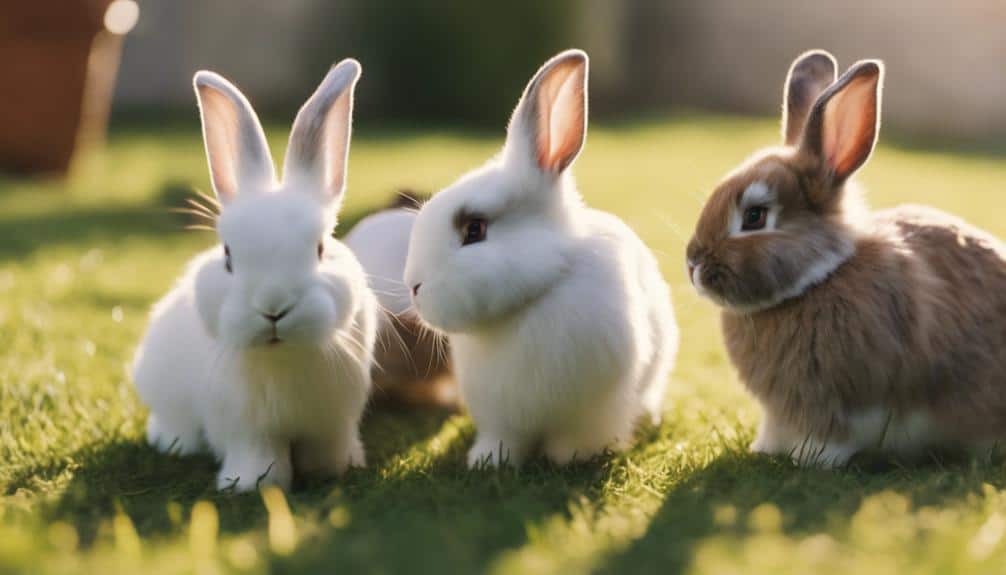
Understanding the nuances of your pet rabbit’s social interactions can greatly enhance your ability to communicate and form a strong bond. Rabbit body language is intricate and multifaceted, reflecting various social interactions that are important for trust-building.
For instance, grooming behavior isn’t only essential for cleanliness but also serves as a means of marking territory and spreading scent among rabbits. When your rabbit engages in grooming, it often signifies acceptance and comfort within its environment.
Nipping is another common social behavior, generally non-aggressive and aimed at seeking attention or engaging in mutual grooming. While it might seem alarming at first, recognizing nipping as a benign interaction can help you respond appropriately and foster a positive relationship.
Additionally, a rabbit’s submissive posture, characterized by a flattening stance, typically indicates fear or submission during social interactions. Recognizing this behavior is critical for understanding your rabbit’s emotional state and avoiding actions that may induce stress.
A gentle nudge from your rabbit signals a desire for petting and further trust-building, whereas a hard nudge usually means it wants to pass or communicate something more urgent. Mastering these cues can greatly improve your bond and communication with your pet rabbit.
Common Vocalizations
Recognizing vocalizations, such as purring and grunting, will further enhance your ability to interpret your pet rabbit’s emotional states and needs. Understanding these sounds is vital for ensuring their well-being and addressing any potential issues promptly.
- Purring: Soft teeth grinding in rabbits, often equated to purring in cats, typically indicates contentment and relaxation. It’s a significant sign that your rabbit feels secure and happy in your presence.
- Grunting: This vocalization is a clear indicator of displeasure or disapproval. If your rabbit grunts, it’s important to assess their environment and interactions to identify the source of their irritation.
- Loud Teeth Grinding: Unlike the soft purring grind, loud teeth grinding can signify pain or discomfort. This requires immediate attention, as it may indicate a health issue needing veterinary intervention.
- Screaming: A rare but alarming vocalization, screaming is a distress signal that typically means severe pain or fear. If your rabbit screams, it’s vital to act swiftly to identify and alleviate the cause of their distress.
Abnormal Behaviors
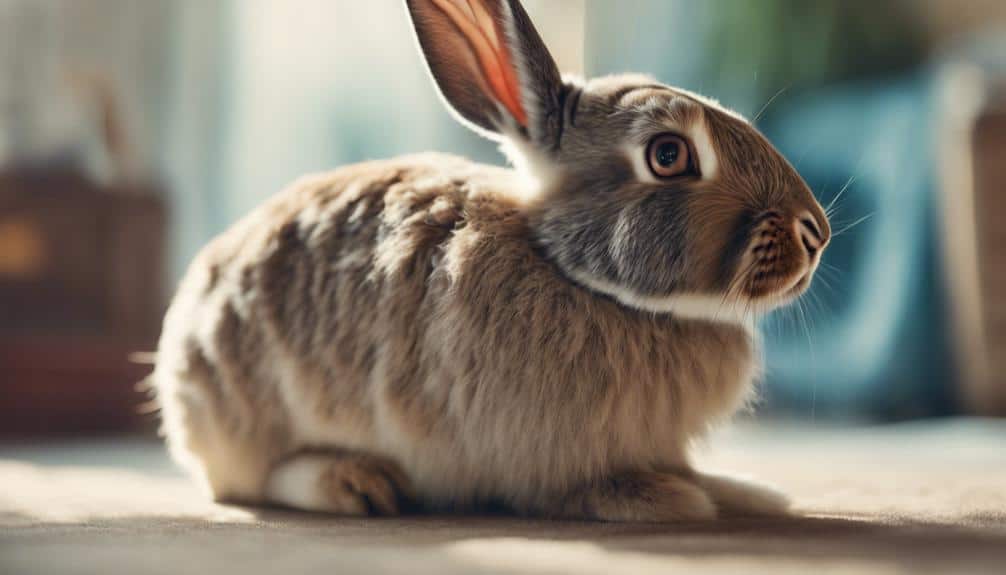
When your pet rabbit exhibits abnormal behaviors, such as excessive aggression, obsessive circling, or persistent hiding, it often signals underlying health or environmental issues that require immediate veterinary assessment. Recognizing these signs of stress is vital for the well-being of your pet rabbits.
Abnormal behaviors can manifest in various ways, including signs of stress and unusual behaviors. Excessive aggression towards humans or other animals is not typical and may indicate discomfort or health issues. Obsessive circling or head tilting often suggests neurological problems, while constant hiding can be a sign of fear or illness. Overgrooming, fur pulling, and excessive chewing are also indicators of stress that shouldn’t be ignored.
Consider the following table for a quick reference:
| Behavior | Possible Cause | Action Required |
|---|---|---|
| Excessive Aggression | Discomfort, pain, territoriality | Immediate vet visit |
| Obsessive Circling | Neurological issues | Veterinary assessment |
| Persistent Hiding | Fear, illness | Environmental check, vet visit |
| Overgrooming | Stress, boredom | Enrichment, vet consultation |
| Abnormal Urination | Health issues (e.g., UTI) | Veterinary examination |
It’s essential to seek veterinary advice if your rabbit displays any abnormal behaviors to address potential medical or behavioral issues promptly. This proactive approach ensures your pet rabbits maintain their health and freedom.
Conclusion
By understanding your pet rabbit’s body language, you can more effectively meet their needs and foster a positive relationship. Recognizing signs of alertness, joy, and discomfort allows you to create a safe and stress-free environment, enhancing their overall well-being.
Stay observant of their behaviors and vocalizations to identify any potential health issues early. This evidence-based approach guarantees you’re providing the best care, promoting a healthy and happy life for your furry companion.

